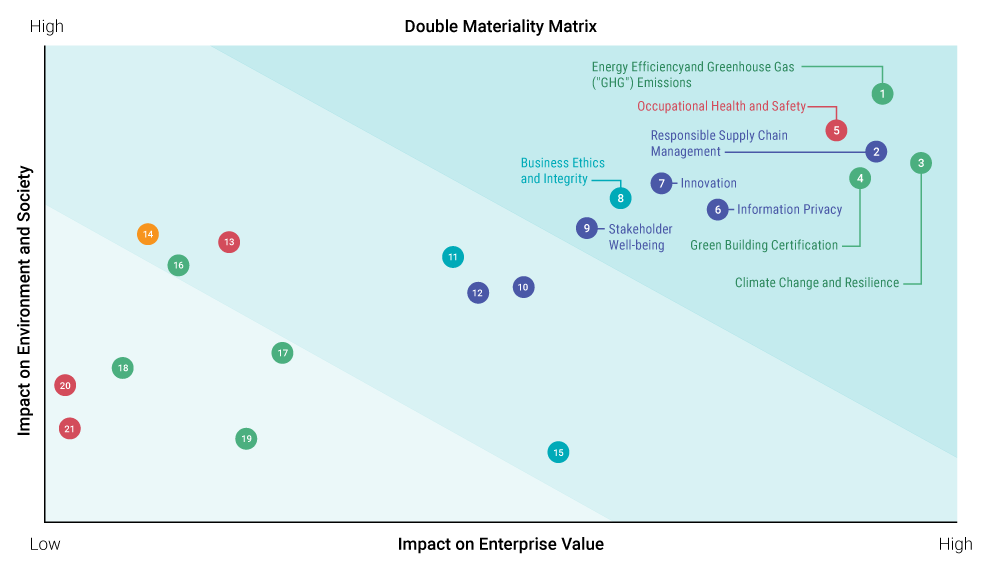Stakeholders' interest is central to the determination of our sustainability agenda. Our dynamic, year-round stakeholder engagement activities allow us to gather diverse views, opinions and expectations from our key stakeholders, which are material to our business, on a continuous basis.

Engage different stakeholders via diversified channels and approaches
Analyse and evaluate feedback collected
Devise action plan for further improvement
Our internal and external stakeholders are grouped into nine categories and engaged through various regular communication channels. These help us enhance our communication transparency, anticipate our stakeholders' needs, and identify possible emerging risks and opportunities to our business operations.
Each year, we also design a thorough stakeholder engagement process to identify key sustainability topics, assess topic materiality, and gain valuable feedback on our strategy, performance and initiatives.
Customers and Tenants
Government and Industry Associations
Academia
NGOs
Media
Employees
Suppliers and Contractors
Local Communities
Investors and Shareholders
Stakeholder
Groups
As stakeholders' concerns and expectations may change over time, we have gone through a rigorous materiality assessment process annually to prioritise topics that are important to stakeholders and our business, keeping abreast of the sustainability trends that shape our industry and business.
Identifying Relevant Topics

Identifying Relevant Topics
Identify shortlist topics following thorough consideration of research findings, with management approval.
Collecting Stakeholder Feedback

Collecting Stakeholder Feedback
Feedback from material internal and external stakeholders was collected through a series of engagement activities, including surveys, interviews and focus groups.
Prioritsing Material Topics

Prioritsing Material Topics
Followed by the engagement activities, the level of the materiality of each sustainability topic was assessed based on:
- Survey scoring on its importance to stakeholders and importance to the business of KPL
- Feedback collected in interviews and focus groups
- Peer benchmarking results
The assessment result was plotted in the materiality matrix, where sustainability topics were categorised into three tiers – most material, moderate material, and less material for further validation.
Validation

Validation
The list of material topics and materiality assessment result was presented to the Sustainability Steering Committee for review.
The double materiality matrix maps 22 sustainability topics, with their level of importance to stakeholders (y-axis) and their level of importance to our business (x-axis). Overall materiality combines both internal and external factors, including the Group's overall strategy, mission, resources, industry trends and stakeholders' concerns.

Tier 1: Material Topics
Tier 2: Moderate Topics
Tier 3: Monitored Topics
Material Issues by Topics

GHG Emissions and Energy Efficiency

Sustainable Buildings

Climate Change and Resilience

Waste Management

Water Consumption and Conservation

Biodiversity

Sustainable Finance

Occupational Health and Safety

Human Capital Management and Development

Labour Practices and Human Rights

Diversity, Equity, and Inclusion

Community Engagement, Development and Investment

Heritage and Culture

Responsible Supply Chain Management

Service and Product Quality

Stakeholder Well-being

Customer Engagement and Collaboration

Innovation

Business Ethics and Integrity

Information Privacy and Security

Economic Performance

Risk and Crisis Management
We are committed to identifying and addressing the material issues that are most relevant to our business. In this regard, we have identified the key potential risks/opportunities associated with our selected material issues:
-
Environment
GHG Emission and Energy Efficiency:
Adopting energy efficiency and transition measures reduce our greenhouse gas emissions throughout value chain, supporting our alignment with Paris Agreement and reducing climate-related impact to the society and environment. Investment in energy transition will reduce excessive emissions and minimise our external impact that could otherwise adversely impact our tenants, the surrounding communities and the environment (e.g., casualties and incidents under more frequent extreme weather events).
Sustainable Buildings:
Implementing sustainable practices across the entire lifecycle of our buildings, from construction to management, helps lower environmental impact throughout our value chain while promoting the wellbeing of individuals and communities. By investing in green building methods, we can reduce exposure to sustainability-related risks that might otherwise negatively affect our tenants, local communities, and the environment.
Climate Change and Resilience:
As climate change imposes direct impacts on our business operations, it is one of our material ESG risks. Climate risks and opportunities include increased severity of extreme weather, rising mean temperature and heatwave, tightened building energy codes and guidelines, increased market demand for climate-resilient properties.
-
People
Human Capital Management and Development:
At Kerry Properties, we foster a workplace that values diversity through targeted initiatives aimed at recruiting from diverse talent pools. Since 2021, we have operated the ESG Think Tank — an affinity group comprised of colleagues with a passion for sustainability to contribute ideas and mobilise the workforce to organise activities as a bottom-up approach, in turn driving positive environmental and social change within and beyond the organisation. Additionally, our Buddy Training Programme includes a 3-month orientation period, during which mentors are assigned to new joiners at the property level. These diversity initiatives are overseen by our managerial staff.
-
Value Chain
Responsible Supply Chain Management:
Failure to adopt supply chain management measures can result in the Group's reputational damage and public scrutiny. By close monitoring, auditing, and collaboration with suppliers, we can mitigate supply chain risk. We have included requirements for suppliers on key social and environmental issues in the Vendor Code of Conduct, which is communicated bilingually to all suppliers in Hong Kong and the Mainland.
We encourage our suppliers to uphold standards relating to maximum working hours, minimum living wages, and grievance handling for disciplinary practices. We also advocate for the protection of fundamental labour rights, including freedom of association and collective bargaining, as permitted by law in the regions where they operate.
Service and Product Quality:
We maintain rigorous safety protocols for services and products, including:
- Regular risk assessments under ISO 45001 and external safety audits
- Regularly testing of emergency response procedures
- Mandatory employee training programmes, such as fire drills and chemical spillage drills
- Comprehensive incident investigation systems with corrective action plans under ISO 45001
-
Governance
Business Ethics and Integrity:
Our whistleblowing mechanism offers confidential reporting channels in English, Cantonese, and Mandarin. While safeguarding individual anonymity, we track all reports received, categorise types of misconduct, and implement appropriate corrective measures. Trends are reviewed annually by our Board.